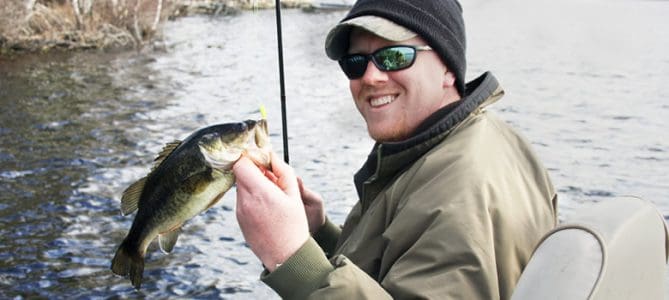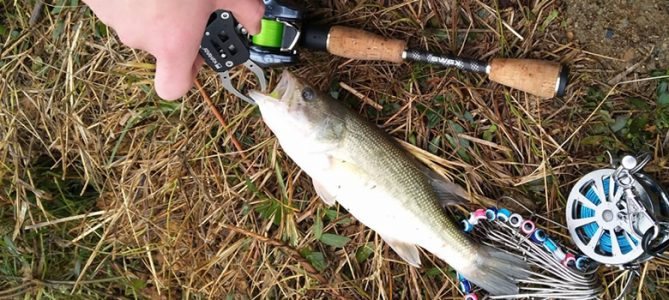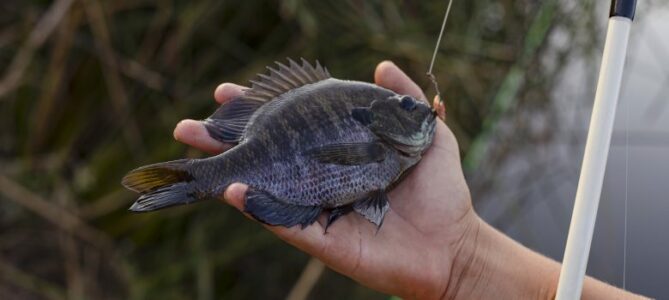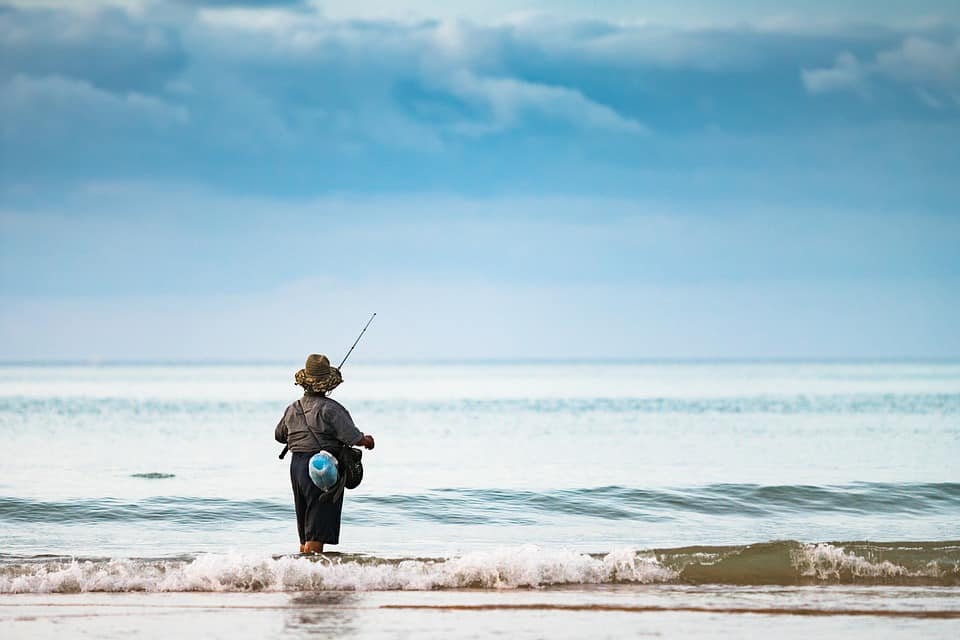If you buy via a link on this page, we may receive a commission, at no extra cost to you.Learn more
Some of the best fishing you can have is before a storm. The pressure starts to drop and the bass starts to go crazy. The pre-storm feeding frenzy is often the best fishing you’ll encounter. But what about after the storm?
For whatever reason you find yourself bass fishing after a thunderstorm, it can be a challenge getting the bass to bite. But that doesn’t mean you should give up. Your time fishing is limited, and even if the conditions aren’t perfect, you can always catch fish if you’re using the right techniques and lures.
Yes, fishing after a thunderstorm can be challenging. But isn’t overcoming a challenge even more fun? Ideally, you want to catch as many fish as possible. Fishing after a thunderstorm is not the best time to catch a lot of fish. But on those challenging days on the water, even catching one fish can be the difference that turns a disappointing day into a happy one.
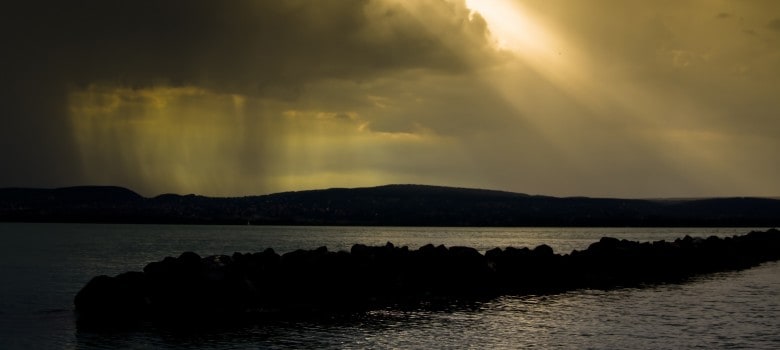
We’ve done the research and we’ve been out there on the water after a storm. Now it’s time to share that knowledge with you. If you find yourself fishing after a thunderstorm, you are going to want to be prepared. So, we have prepared you with 20 different tips for bass fishing after a thunderstorm.
1. Invest in a Digital Barometer
While most anglers know that fishing after or during a storm often leads to pulling in a boatload of fish, not many know exactly why. The reason is the barometric pressure in the air. When the pressure changes suddenly, the fish get turned on to eat their next meal. With a digital barometer, you can track exactly when, and where, the pressure is changing.
This handheld digital anemometer from BTMETER can do it all for you and is waterproof to boot. It’ll measure wind speeds, wind chill, wind temperature, humidity, dew point, barometric pressure, and altitude. For under $40, you can’t do much better than that.
- ➤【MULTIFUNCTION ANEMOMETER】BT100WM wind...
- ➤【HIGH PRECISION】Digital wind meter for...
- ➤【EASY TO USE】Measures different readings...
2. Watch for a Big Drop in Pressure
The best time to fish for bass is right after there has been a big drop in pressure. With your digital barometer handy, you can see exactly where and when that will happen. As the pressure drops, the fish start biting more and more. Typically, the drop will happen up until the end of the storm. If you wait too long, you may miss the bite.
On the other hand, if you have a bigger storm system move-in, you may have good fishing for multiple days, rather than multiple hours. You’ll need to put your weatherman hat on, but the extra effort will be more than worth it once you’re on the water pulling in big bass by the bunches.
3. Don’t Wait Until After the Storm is Over
If you don’t mind getting a little wet or have invested in quality rain gear, get out there during the storm. It may not be the best selfie weather, but who cares if the fishing is good? At the same time, make sure to stay safe, and continue tracking the barometric pressure. When a thunderstorm system first comes in, the pressure will likely be high. If you watch to see when the pressure starts dropping, that’s when you want to stop doing whatever you’re doing and get a line in the water.
4. Dropping Barometric Pressure is Good, Rising Barometric Pressure is Bad
This is a simple reminder of what pressure is good and what pressure is bad. When the barometric pressure starts dropping, that means you’re going to have a good time fishing. When the pressure starts rising, that means it’s going to be a challenging day.
Often right after a storm, a cold front will come in, and with it, a rise in barometric pressure. This is not the best time to be out fishing. However, any time fishing is a good time, so keep reading the rest of these tips and make sure you are prepared for when the barometric pressure starts to rise. On your digital barometer, 30.5 represents high pressure, while 29.6 represents low pressure.
5. Where to Fish When Pressure is High
Sometimes, you don’t have a choice whether or not to fish during a rise in barometric pressure. If you’re out on a big lake and a storm front quickly came in and left, you aren’t going to pack it in and go home. If you find yourself fishing right after a thunderstorm and notice an increase in pressure, look for bass in cover, and in deeper water.
6. Use Jigs to Fish Deep
A jig with enough weight to get down deep will be effective after a storm front comes through. Right after a thunderstorm, the prey that bass is feeding on will swim deeper, so you need to go where the fish are. A jig with a plastic worm and maybe some fish guts if you have them can be the perfect lure in this situation. You’ll be able to target and catch smallmouth bass with this technique.
7. Use Lipped Crankbaits to get Deep Down
Another great lure to use for bass at all times is a crankbait with a lip designed to dive deep. You can target that smallmouth bass again with deep-diving cranks. Make sure to cast out far enough to give the lure time to dive down deep. A baitcasting rod and reel will work best with crankbaits, both for reeling them in and casting them far out.
8. Run Lipless Plugs Along the Dense Cover
After a thunderstorm, bass will also tend to head to dense cover to find their prey. A lipless plug can be the perfect lure for running in and out of cover. Largemouth bass will be found on the cover, and smallmouth bass will be hanging out on the edges of the cover.
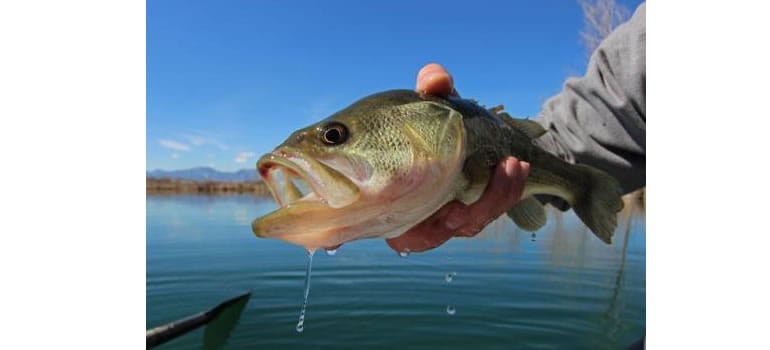
A plug is just another name for a crankbait. It’s the old-school way of referring to modern cranks. Typically, plugs were made of wood while newer crankbaits are often made from plastic. The key here, no matter what you call the lure, is to get a lipless version when targeting bass in the cover. Without a lip, the lure won’t dive as deep and you can run it through cover easier.
9. Invest in a GPS Fish Finder
If your only time to fish is after a thunderstorm and the high pressure that comes after the storm moves out, you will be very thankful to have a GPS fish finder by your side. Fishing is undeniably tougher after a thunderstorm, so to maximize the time you do have to fish, a GPS can lead you to where you are most likely to have success.
GPS fish finders can get really expensive, but for just over $100 you can buy the highly-rated Garmin Striker 4. Don’t go fishing without it.
- Clear Vu scanning Sonar shows you more of what is...
- The power of simple offers a keyed interface with...
- Waypoint map: Use the way point map to easily...
10. Understand Water Currents
After a lot of rainfall from a thunderstorm, water currents will pick up pace and strength. The bass does not like the stronger moving currents and will hang out behind the current to rest. If you can locate the current, you can locate the bass. A GPS fish finder will help you determine where the currents are and should show you where the bass hanging out.
The currents also bring new bait fish into play that isn’t strong enough to swim out of the current. Bass will be hiding out and picking off the fresh new prey, so this is a perfect spot to place your lure and pull in a big lunker.
11. Find the Feeder Streams
Another effect the extra rainfall has is sending insects into the streams and creeks that feed into a lake or larger rivers. The bass knows this, and they will move toward those feeder streams to take advantage of the new influx of prey. If you’re struggling to catch fish after a thunderstorm, locate a feeder stream to find the bass that is actively biting.
12. Use Vibrating and Rattling Lures in Muddy Water
Rainfall after a thunderstorm will cause sediment to come off the banks and stirs up the water making it muddy. Muddy water makes it easier to approach the bass, but it also makes it harder for the bass to see your lure. Bass can sense the smallest of vibrations in the water, so having a vibrating or rattling lure can be your saving grace when fishing after a thunderstorm.
13. Use a Slow Retrieve
Bass are lazy after a thunderstorm. They’re looking for calm water and aren’t as hungry due to the rise in barometric pressure. This means that the bass is less likely to go after a fast-moving lure. Keep your retrieve slow and steady to give the bass every opportunity to take a bite.
You should also try to incorporate periodic pauses into your retrieve. If a bass sees a slow-moving lure, he may still be too lazy to go after it if you’re fishing after a thunderstorm. Give your lure a long pause periodically while you slowly retrieve it.
When the bass sees your motionless lure, that may be all they need to convince them that the next meal has arrived. Don’t be afraid to pause for 10 seconds, even up to 20 seconds. You never know when a big old bass may be swimming by and notice your lure.
14. Try a Trick Worm
You can easily rig up a trick worm using the popular Zoom Bait worms. You can buy a 20-pack of Zoom Bait Trick Worms at Amazon for less than $8, a great deal!
- Zooms Basic floating worm
- Great for drop shotting
- All Zoom Baits are Salt Impregnated to make fish...
The way to rig up your trick worm is to put your hook through the middle of the worm so that half of the worm is hanging off either side of the hook. What this does is cause the worm to flop and swim trick-style underwater. You can use a trick worm with great effectiveness to coax even the laziest of the bass who have no intention of biting anything else.
Make sure to twitch your bait, keep the retrieve slow and steady, and you may find your new favorite lure. You may also want to tie the worm to the hook using a piece of twine to make sure the worm doesn’t fall off. The trick worm works perfectly after a storm because sometimes it will be one of the only rigs that get enough attention from the bass to strike.
15. Look for the Runoff
When rainfall soaks up the ground on the edges of the water, a runoff will begin after enough rain has accumulated. The bass is attracted to the runoff because as fresh new water, it has more oxygen than the rest of the lake. If you can identify the part of the lake that is receiving the most runoff, you’ll likely also identify where the bass is hiding out.
Just as the bass are attracted to the runoff, so are baitfish. This makes the areas with the highest runoff the ideal spots not only for bass but for bass that are actively feeding. You can locate the runoff by finding the muddiest water. This is the water that has been recently dumped on.
16. Watch the Wind
The wind is a key factor to consider because it will blow the baitfish into the bank. And when you can find the baitfish, you will find the bass. When you follow the wind to the baitfish, you want to use a lure that resembles the bait the bass are going after. Chatterbait is a type of lure that bass pros will use in this situation, and that means that you should try using them too.
17. Don’t Wait to Get Back on the Water
As long as the storm has passed and it’s safe to go out, don’t hesitate to get your butt back on the water. You never want to waste any of the time you have fishing. You also want to get ahead of the incoming cold front. After a storm, a cold front is likely to come through, and the cold will turn the bass off. If you can get right back on the water immediately following a storm, you’ll have a better chance of catching bass before they turn off with the rise in barometric pressure.
18. Be Careful
While you don’t want to wait too long to get back on the water, you also need to be safe when going outside when storm fronts are in the area. Check the radar and be sure that a second wave of thunderstorms isn’t going to come right back in. Lightning is not something you want to mess around with.
If you are dead set on fishing all day and have to stop because of a nasty thunderstorm, just make sure that you are being safe when you head back out on the water. If another storm front comes in, it may mean great fishing, but it also may mean lightning and high winds that could cause a rocky time on the water if you aren’t in a big boat. Make sure that you are staying safe when fishing after a thunderstorm. As important as fishing is, your safety is even more important.
19. Don’t Give Up
It’s easy to get frustrated when you’re fishing. It’s even easier to get frustrated when fishing after a storm and the bass have stopped biting. Always remember that fishing is fun, no matter how many fish you’re catching. Hopefully, these tips will help you to catch more bass, because of course, it’s much more fun when you’re catching a lot of fish. But also remember that fishing is an escape. It’s your time on the water. It’s a time to relax, unwind and take a break from the rest of life.
If you’re with friends, it’s a great time for camaraderie, and if you’re fishing by yourself, it’s a nice time for reflection. If you’re fishing after a thunderstorm, you may have plenty of time for reflection because fishing isn’t always the best. But don’t give up! Enjoy your time on the water, and be thankful for the time you have to fish.
Not giving up also means not casting a couple of times and moving on to the next hole. It may take five to 10 casts before you can coax a lazy bass to strike after a thunderstorm. If you’ve found a good spot where you’re sure the bass are hanging out, don’t give up too easily. Keep pounding that spot with casts and you may be rewarded with a catch.
The Bottom Line on Bass Fishing After a Thunderstorm
While the fishing may not be the best after a thunderstorm, hopefully using these tips will help you to catch bass when others are giving up. Fishing before a storm is easy. And while bass fishing after a thunderstorm is a challenge, it’s a challenge that you can conquer. Some of the proudest moments you’ll have fishing is when you overcome a challenge, even if it means catching just one bass. That one bass will be one that you remember.

